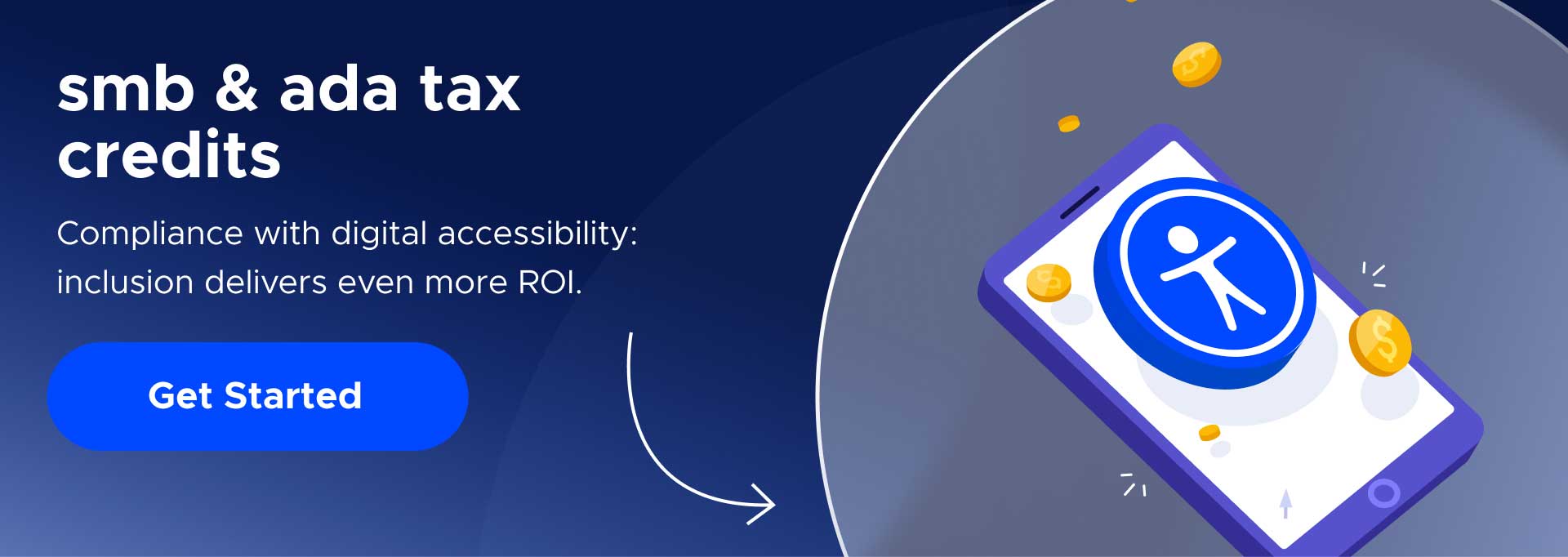Accessibility & the ADA Tax Credit for Small Businesses

Most people and businesses don’t see tax season as a reason to celebrate. However, there’s a bright side for small businesses that embrace digital accessibility: the ADA tax credit. If you are part of a small business that may invest in website accessibility, this tax credit can help you reclaim costs. If you haven’t integrated web accessibility, these tax incentives may inspire your decision-makers to back and fund an ADA-compliant website.
How to qualify for ADA tax credit
Small businesses with gross receipts under one million dollars or under 30 employees qualify for ADA tax credit eligibility. So, how do ADA tax credit requirements and documentation work? Use IRS Form 8826 for these tax benefits (the Disabled Access Credit), and reference Title 26, Internal Revenue Code, Section 44. Tax credits are different from tax deductions. A tax deduction decreases taxable income and the tax owed. By contrast, tax credits are deducted from the tax you owe later. For example, you can take a 50 percent credit up to $10,250 for expenditures over $250, resulting in a $5,000 maximum credit. If your business qualifies for the ADA tax credit, use Form 8826 in your application process.
See the terms for claiming ADA tax credit amounts below:
- Example 1: Your company spends $5,000 on an accessibility audit or enhancing your website’s accessibility. Only expenditures over $250 qualify, so subtract $250 from $5,000 to get $4,750. You can claim 50 percent of the $4,750 as a credit. Just deduct $2,375 from what you owe on your next return.
- Example 2: Your company spends $12,000 for accessibility auditing or web accessibility improvements. This exceeds the $10,250 limit, of which you can claim $10,000, with the 50 percent credit amounting to $5,000.
What does ADA tax relief relate to digital accessibility?
Small businesses incur certain costs when they install a wheelchair ramp, provide a sign language interpreter for an event, or offer print materials in Braille. ADA tax credit benefits help them with these costs. However, ADA tax credit benefits also relate to website accessibility improvements, which are critically significant for people with disabilities. So, creating a barrier-free internet is critical, and giving businesses an ADA tax incentive to make digital accessibility a priority is a welcomed initiative.
The truth is most websites are not highly accessible. They contain obstacles for users with various disabilities. Enhancing a website’s accessibility also involves costs, particularly when retrofitting an existing website instead of building a new one with accessibility in mind. The same tax benefits to accommodations like wheelchair ramps also apply to websites and can help site creators with the associated costs.
Why accessibility matters beyond the tax incentives
The ADA tax credit is undoubtedly advantageous, especially for small businesses with fewer resources. But web accessibility goes well beyond tax deductions and incentives. An accessible website can provide a legal safety net, elevate online retail performance, and promote inclusivity for people with disabilities.
Accessibility has never been more urgent as federal courts increase related lawsuits against non-compliant companies. ADA tax credit regulations Moreover, your company is vulnerable no matter how small you may think it is. Not just the Fortune 500 players face punitive action, and smaller businesses are even less prepared to absorb related costs.
On the positive side, an accessible website that follows regulations and qualifies for the ADA tax credit empowers you to welcome the 61 million Americans with disabilities, representing an $8 trillion global market.1
Additional tips for tax benefits
In addition to ADA tax relief, other tax breaks can slash costs. See the examples below.
-
ADA Tax Deduction
This applies to organizations that completed ADA requirements, with a $15,000 annual deduction maximum. So, your company could qualify for the tax deductions even if you don’t qualify for the IRS ADA tax credit. Refer to IRS Publication 535 for all related details.
-
Combined ADA Tax Incentives
Small businesses may qualify for the ADA tax credit and ADA tax deduction with ADA compliance costs that exceed $10,250.
-
The Architectural Barrier Tax Deduction
Businesses can claim a maximum annual deduction of $15,000 for qualified expenses. In addition, businesses can combine the Disabled Tax Credit and the architectural/transportation tax deduction in the same year if the costs satisfy respective guidelines.
Count on UserWay for your accessibility needs
Unfortunately, most websites aren’t accessible in today’s world, and people with disabilities are the ones who suffer. But UserWay’s AI-Powered Accessibility Solution can help you improve accessibility and compliance affordably. Of course, small businesses can always use a break financially, especially if you’re at the beginning of the web development process. Regardless of where you are in your journey, the ADA tax credit can provide some much-needed help.
See the IRS Tax Credits and Deductions page for ADA tax credit information.
Common FAQs
How Does the ADA Tax Credit Apply To Web Accessibility?
The ADA tax directly impacts businesses that develop accessible websites. Qualifying expenditures cover numerous accessibility practices or integration categories. In addition, here are some key variables to consider in your annual accessibility fee:
- Homepage modifications
- Page format and hierarchy
- Live chat services
- All related content
- File and media fixes
What Are the Conditions of the ADA Tax Credit?
The ADA tax credit can be applied for and earned annually. However, you can’t apply costs to claim a credit exceeding the previous year’s spending limit. But, if the credits you qualify for exceed the taxes you owe, you can apply that surplus to the next year.
The tax credit covers the following accessibility and ADA-related expenditures:
- Web accessibility & optimization
- Language interpreters
- Adaptive equipment
- Printed materials
- Elimination of physical obstacles
- General consulting
Is the ADA Tax Credit a One-Time Deal?
Fortunately, you can get this credit any year your website meets ADA compliance requirements. However, you can’t use the ADA tax credit with other credits in your tax returns. However, this tax break should incentivize you to update your site regularly for ADA conformance.
Please note that UserWay is not responsible for any tax-changing or misinterpreted information. This post is meant to be informative and does not replace the advice of an accountant or tax professional.





Share